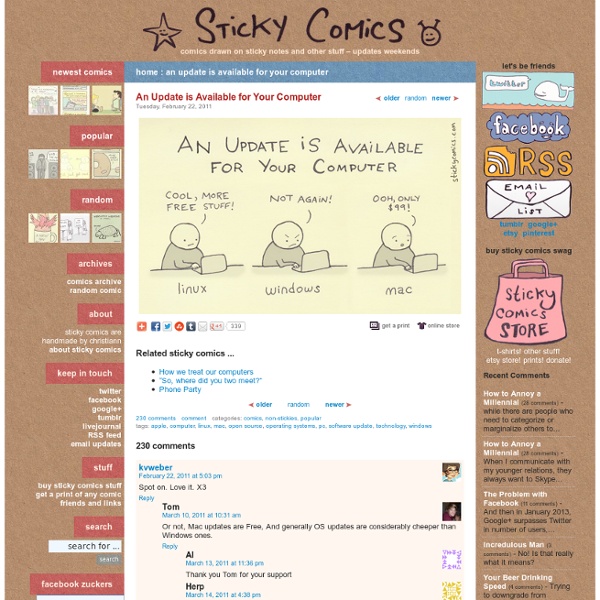



Cats Can See Stuffs We Cant Man, those cats can see stuffs we can’t. Enjoy images below: Check out other amazing animal tales and photos . More great articles Feedbox Trackbacks THANKS OBAMA Most Upvoted 1438 votes He is all rigth now 746 votes The Dark Knight Reads 739 votes Come on and Slam! 431 votes Stealth Little Buddy 405 votes Happy Easter! Share Tweet Email Favorite By Unknown Share: 138 Share on twitter Share on google_plusone_share Share on pinterest_share Share on stumbleupon Share on reddit Share on email Reposted by and 43 more... More From Cheezburger From Around the Web Recommended by Cheezburger Comments Scottahemi Obama isn't a Commie, he's a Socialist. User ID: View more items peko666 I just had to take the bait. User ID: DavidB1111 That's not how Communism works. User ID: R315r4z0r The easiest way to describe communism is the abolition of private property. DavidB1111 likes this. User ID: Thank you. ArcherC Propagandizing, they're doing it right. User ID: Jackal_XIII likes this. Slaggingham
2012 Predictions Everybody’s got one. A prediction about what the devil is going to happen during the winter solstice of 2012. That’s the end of the world, say some. Here we have a graphic, provided by InformationIsBeautiful.net, about various 2012 predictions and possible horrid scenarios. The believers generally fall into two camps: those who think the Earth’s population will collectively undergo a positive physical or spiritual transformation, and those who think civilization will be completely annihilated or, instead, transubstantiate into a living hell for all. The believers have a number of varied theories, and I suppose some think they are mutually exclusive, while others believe they can overlap. Many of ideas that believers hold onto are based on completely historically incorrect information. This design isn’t winning many points in the creativity or “amazing use of colors” department. Content: A- An excellent research job by the graphic’s creators.
Link Left a Little Too Early Most Upvoted 1438 votes He is all rigth now 746 votes The Dark Knight Reads 739 votes Come on and Slam! 431 votes Stealth Little Buddy 405 votes Happy Easter! Share Tweet Email Link Left a Little Too Early Favorite View Fullscreen By Unknown Share: 161 Share on twitter Share on google_plusone_share Share on pinterest_share Share on stumbleupon Share on reddit Share on email Reposted by and 176 more... More From Cheezburger From Around the Web Recommended by Cheezburger Comments Jll123567 Give him a chance link User ID: hotdogpuppy xD this was on Zelda Dungeon's Majora's Memes. User ID: Thatguyonthatbumonthelog Plagiarised and old. User ID: Super-Sky There are two ways to describe this One, Forever Alone. User ID: Charioteer Oh, hey! User ID: Reject You don't have to be able to remove anything. AquaShldEXE
The 6 Crappiest Interview Questions All artwork and content on this site is Copyright © 2015 Matthew Inman. Please don't steal. TheOatmeal.com was lovingly built using CakePHP All artwork and content on this site is Copyright © 2015 Matthew Inman. TheOatmeal.com was lovingly built using CakePHP Excellent Ads Created: 05/13/2010 Visits: 1522868 Online: 1 Moustaches make a difference Moustaches make a difference Advertising Agency: TBWA\Singapore, Singapore Creative Directors: Hagan de Villiers, Gary Steele Art Directors: Reginald Ocampo, Danny Teo Copywriters: James Holman, Martin Loh Illustrator: Reginald Ocampo, Roger Tan Developers: Tony Chew, Sean Tan Production Managers: Sally Sim, Allen Pattiselanno Account Service: Jaclyn Lee, Alrick Dorett Published: November 2010 Wonderfull ads for Movember. 29th of November 2010 Probably Related Mustache Handkerchief Symmetry Sucks The Original Hipster Music can make a difference Travel Status Back home since 56 days Currently in: Switzerland Oh dear, do you realise how old your browser is?
Wrist Rescues: 16 New Ways to Keep Naked Wrists Occupied Remember when the question “What time is it?” was followed by everyone within earshot glancing at their wrists? Now that we all carry around smartphones, we are more likely to reach into a pocket than anything when presented with a request for the time. Goofball artist Lunchbreath came up with 16 other things we can all do with our wrists now that they’re free of those pesky wristwatches. Whether your wrist is feeling naked without its old watch or you just hate to see any usable part of your body go to waste, these ideas give some great jumping-off points for filling the void left by the de-popularization of wristwatches. What type of person would wear mobile turntables or a portable Oreo holder on their wrist? To be completely fair, some of these ideas aren’t all that silly. Carrying food on one’s wrist, though, seems like one of the worst ideas ever. We’re all for adaptive re-use of obsolete objects, and the wrist has certainly lost its previous place as keeper of the timepiece.
Demotivational Posters Album by Sarah06 Motivational posters have been repeatedly parodied, and parodical demotivational posters have become an Internet meme. There are literally 1000s circling the internet. I'm a huge fan of demotivational posters, they always crack me up! So I decided to create an album for it. I manually selected my 300 most favorite demotivational posters for you, so I hope you enjoy them! Sarah 7Up (3 years and 73 days ago - by Sarah06 - 733415 views - Max Resolution: 600 x 445) 50 Fist Dates (3 years and 73 days ago - by Sarah06 - 731898 views - Max Resolution: 600 x 580) Admit It (3 years and 73 days ago - by Sarah06 - 731949 views - Max Resolution: 540 x 432) Adoption (3 years and 73 days ago - by Sarah06 - 734702 views - Max Resolution: 600 x 464) Lesbians (3 years and 73 days ago - by Sarah06 - 732495 views - Max Resolution: 600 x 750) Always (3 years and 73 days ago - by Sarah06 - 731204 views - Max Resolution: 600 x 460) America Tattoo Have You Ever Been So Angry Angry Eater Anteaters Astrology Australians Bacon
Poke-m-my-god-what-is-that